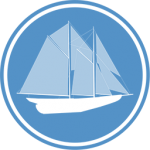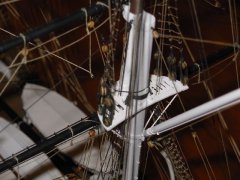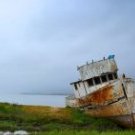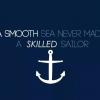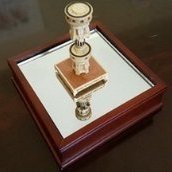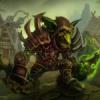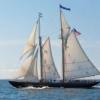-
Posts
209 -
Joined
-
Last visited
Reputation Activity
-
 genericDave got a reaction from hexnut in Bluenose by genericDave - FINISHED - Model Shipways - 1:64 Scale
genericDave got a reaction from hexnut in Bluenose by genericDave - FINISHED - Model Shipways - 1:64 Scale
This last week has been spent playing around with new toys to try and overcome a problem.
I recently started work on the windlass and machinery. The first piece I worked on was the countershaft assembly. My very first step was to clean up the metal casting provided by the kit. This piece is basically a rod with two gears on it.
Naturally, I broke this piece while working with it. I snapped the rod.
I cut the gears loose from the rod, and I am holding on to those as a safety net - I can always drill holes through them and slide them onto my own brass rod.
But...I just got a new Proxxon MF70 mill and I've been looking for things to try and make with it. I decided to take a stab at making replacement gears using the mill.
The larger gear is 1/4" in diameter, so I started with a 1/4" diameter aluminum rod. I used a 3mm bit on the mill to do most of the work, and a 1mm bit to cut the 'teeth'. I used my drill press to drill a hole through the center. The rotary vise for the Proxxon made cutting the teeth pretty easy once I figured out the # of degrees between cuts.
It took 4 tries, mostly because I was still learning how to use the mill, but I did manage to make a usable piece. It isn't perfect, and the teeth are different than the kit-provided piece, but I think it actually looks cleaner and more precise than the cast piece. Once this is painted, I think it will look fine!
I was very happy with the level of precision on the Proxxon. It cut through the aluminum easily. I'm sure it might have a tougher time if I were doing something larger (and the Proxxon is very much for model work, not larger-scale machining like you'd do with a bigger mill). All the milling was done manually (turning dials) since I'm still waiting on the motor mounts for my CNC conversion. (Although I have gotten all the electronics working and the control software halfway written).
Anyway, I haven't actually made any progress on the ship, but I've managed to make a gear, and I've very happy with that accomplishment for the week!
-
 genericDave got a reaction from etubino in Bluenose by genericDave - FINISHED - Model Shipways - 1:64 Scale
genericDave got a reaction from etubino in Bluenose by genericDave - FINISHED - Model Shipways - 1:64 Scale
Thanks Russ!
Over the last week or so, I've gotten the bowsprit bitts/samson post and the engine box completed.
The bowsprit bitts and samson post were pretty straight forward as the kit provides the key piece as a laser-cut item.
The whole thing went together pretty quickly.
The engine box gave me a bit more trouble. My first attempt was fine until I got it painted, then I notices a few too many imperfections in the wood. I tried to fix them with some filler and repaint, but wasn't happy with the results. The second attempt failed during assembly - I wasn't able to get it square enough.
My third attempt was successful. This time I made a much more rigid internal frame for the box, then used 1/16" sheet material for the 'walls'. The lift out door on the side was simulated by cutting one of the side panels halfway through (so it remained one piece, but looks like two).
The smaller part of the box was built similarly, but I left some open space on the inside frame since this piece has three holes in the walls.
The holes were made by drilling holes then using needle files to square them off. They aren't perfect, but it is what I was able to do with the tools on hand.
The entire thing was primered and airbrushed white.
I decided to try and simulate the hinges on the top. I used some thin brass strip I had on hand and some thin brass rod. These were soldered together.
Once soldered, the three pieces were cut apart and each piece was cleaned up. I filed away a lot of the solder (I always make a mess when soldering), and trimmed the brass strips to be shorter and tapered. I touched them up a bit with some brass paint to make the color a little more consistent. They were then glued on to the roof of the engine box.
I also simulated a small handle/latch using some thin brass wire that came with the kit.
I noticed after I glued it on the deck that despite all my attempt to double-check things, I managed to screw something up. I glued the smaller portion of the engine box so it lined up with the outboard edge of the larger box. It should have been even with the inboard edge. I don't think anyone would notice this once the ship is done (except for me or another Bluenose builder). So, rather than rip it off and risk damaging the deck, I'm going to leave it.
Fortunately when I was positioning it, I was using the inboard hole on the smaller box and the samson post as reference points, since the windlass/machinery touches both of those. So really, the small box is in the right place and the larger box (which nothing else connects to) is just out of position by a small amount.
I don't think there is anything else I can work on to procrastinate - I've got to start in on the windlass and machinery. It shouldn't be difficult, and it will be similar in process to a lot the work I did on some Model Airways WWI aircraft a few years ago (which use a lot of cast pieces to build up the engine). My fear is that there is a lot of potential for detail with this stuff, and my ability to toss stuff and start over will be limited by the use of cast metal pieces.
-
 genericDave got a reaction from Jack12477 in Bluenose by Worldway - Model Shipways - Scale 1:64
genericDave got a reaction from Jack12477 in Bluenose by Worldway - Model Shipways - Scale 1:64
Derek, planking looks great! From your photos it looks like you did a great job with the planks that have to twist going up to the stern post (those didn't line up great for me on my build). It already looks great, but once you get the hull painted, I think the shape is going to look perfect!
-
 genericDave got a reaction from bhermann in Bluenose by genericDave - FINISHED - Model Shipways - 1:64 Scale
genericDave got a reaction from bhermann in Bluenose by genericDave - FINISHED - Model Shipways - 1:64 Scale
Thanks Bob! I was actually looking at your build log the other day to see how you handled the dories...now I know why they were missing
-
 genericDave got a reaction from Zocane in Do I Use Primer?
genericDave got a reaction from Zocane in Do I Use Primer?
I haven't used a sanding sealer, but I pretty much always use a lacquer based primer on everything I'm going paint, but I think it depends on the effect you're looking for. I use acrylic paints (water based), and find that without a primer, the paint tends to raise the wood grain a bit. So, things that are painted without primer look very 'wood-y' and show their grain. When use primer (and sand after the primer dries), I get a much smoother finish (often showing no wood grain). I like that really smooth look so I always use primer.
The primer I use is Tamiya Liquid Surface Primer (grey), and it goes on very thin. So thin that it won't fill any holes, and any defects in the wood still show up. Since it is lacquer based it is a bit of a pain to clean up (can't be cleaned with water), but the results I get are worth it.
I used it on the hull of my Phantom and Bluenose builds, but I think it really comes down to personal preference.
-
 genericDave got a reaction from thibaultron in Do I Use Primer?
genericDave got a reaction from thibaultron in Do I Use Primer?
I haven't used a sanding sealer, but I pretty much always use a lacquer based primer on everything I'm going paint, but I think it depends on the effect you're looking for. I use acrylic paints (water based), and find that without a primer, the paint tends to raise the wood grain a bit. So, things that are painted without primer look very 'wood-y' and show their grain. When use primer (and sand after the primer dries), I get a much smoother finish (often showing no wood grain). I like that really smooth look so I always use primer.
The primer I use is Tamiya Liquid Surface Primer (grey), and it goes on very thin. So thin that it won't fill any holes, and any defects in the wood still show up. Since it is lacquer based it is a bit of a pain to clean up (can't be cleaned with water), but the results I get are worth it.
I used it on the hull of my Phantom and Bluenose builds, but I think it really comes down to personal preference.
-
 genericDave got a reaction from tasmanian in Bluenose by genericDave - FINISHED - Model Shipways - 1:64 Scale
genericDave got a reaction from tasmanian in Bluenose by genericDave - FINISHED - Model Shipways - 1:64 Scale
So, I started in on the dories...
The kit provides 1/64" thick laser cut pieces for each of the 8 dories as well as a little jig you can assemble to help make the boats. I'm only planning on using 4 dories on my ship (two stacks of two instead of two stacks of four), so I figure I've got 4 extras to play with in case I mess up.
I built the jig and started trying assemble a dory. I had a heck of a time. Even with the jig, I couldn't get the pieces to line up and stay in place while I glued them. It wasn't any fun and I quickly realized that making 4 of these was going to be an unpleasant experience for me.
So, I decided to ignore the kit's parts and scratch build a dory. The plans indicate that the kit's dories are simplified - they use a single sheet for each side while the actual dories used three lapped planks. It seems like I could make some frames, attach them to the bottom, then glue on the three planks. Certainly more complicated than the kit's approach, but I think it could be more fun.
I started by scanning the plans for the dories into the computer. I used some illustration software to lay out the five frames, the bottom, and the pieces for the bow and stern. I simplified the frames a bit - the plans show the frames are made from two pieces that overlap in the middle. i'm going with one solid piece for each frame. That should be easier to work with and a little more sturdy.
I cut out one set of the templates and glued it to a sheet of 3/32" thick basswood. This will make the frames a little thicker than they should be, but I'm worried that if I go thinner they will be too fragile. I used my little Proxxon scroll saw to cut out each of the pieces. Most were pretty easy, but 'frame C' took three tries.
Once all the pieces were cut, I scored the bottom piece to simulate individual planks and marked the location of each frame. I glued all the frames on using PVA, and glued the bow and stern in place using CA glue. Even without the planking on the sides, it was already starting to look like a little boat.
I used a sheet of 1/64" thick birch that I had laying around for the planking. I cut three strips for each side and installed them from the bottom up. Each plank overlapped the lower one by a little bit as shown on the plans. With pieces this small, I ended up getting glue everywhere, but since the whole thing is getting painted, I'm not too worried about it.
Next I added the other details, like the battens at the bow and stern and the thwart support for the seats. Everything was primered and painted, then I installed the seats and a cap rail. The plans call for the dories to be a cream or buff color, but I've seen a few other Bluenose builds that used a greenish-gray, and I liked the way that looked. So I painted the outside with a greenish-gray color. I went with tan for the inside, and painted the seats and cap rail white so they had some contrast.
I didn't do a very good job cutting and fitting the cap rail, so that is something I'll definitely have to rethink on the next one, and I'll probably go with thinner material for the next rail. I also used material that was too thick for the seat support rails and seats. I'll need to switch to a much thinner strip next time, and probably mount the seats a little lower (they ended up too close to the cap rail). I also realized at the very end that I had forgotten the cleats.
I didn't bother adding the spray rail, thole pins, or oars as this was just a prototype. By the time I got that far, I had proven this approach would work while also making enough little mistakes that I won't end up using this first dory. So no point in 'finishing' it.
I dropped my prototype dory on the deck to see if the color choices work, and I'm pretty happy with how they work. The dory stands out, but doesn't look out of place on the deck. I also set the dory on the original plans and verified that the size turned out correct (always a concern when you're scanning in and manipulating plans - one small scaling problem and the size can end up off).
After the templates were designed and printed, building this dory took about 3 hours. Since I need four of them (and this one was just a prototype that won't actually get used), that means I've got about 12 hours of dory-building ahead of me. But I found this to be much more fun than building the ones provided by the kit, and I think they will look a better than the kit's dories once I sort out a few issues.
And now I've got a three day holiday weekend and my wife will be out of town, so I hope to get all four built in the next few days!
-
 genericDave got a reaction from mtaylor in Do I Use Primer?
genericDave got a reaction from mtaylor in Do I Use Primer?
I haven't used a sanding sealer, but I pretty much always use a lacquer based primer on everything I'm going paint, but I think it depends on the effect you're looking for. I use acrylic paints (water based), and find that without a primer, the paint tends to raise the wood grain a bit. So, things that are painted without primer look very 'wood-y' and show their grain. When use primer (and sand after the primer dries), I get a much smoother finish (often showing no wood grain). I like that really smooth look so I always use primer.
The primer I use is Tamiya Liquid Surface Primer (grey), and it goes on very thin. So thin that it won't fill any holes, and any defects in the wood still show up. Since it is lacquer based it is a bit of a pain to clean up (can't be cleaned with water), but the results I get are worth it.
I used it on the hull of my Phantom and Bluenose builds, but I think it really comes down to personal preference.
-
 genericDave got a reaction from druxey in Do I Use Primer?
genericDave got a reaction from druxey in Do I Use Primer?
I haven't used a sanding sealer, but I pretty much always use a lacquer based primer on everything I'm going paint, but I think it depends on the effect you're looking for. I use acrylic paints (water based), and find that without a primer, the paint tends to raise the wood grain a bit. So, things that are painted without primer look very 'wood-y' and show their grain. When use primer (and sand after the primer dries), I get a much smoother finish (often showing no wood grain). I like that really smooth look so I always use primer.
The primer I use is Tamiya Liquid Surface Primer (grey), and it goes on very thin. So thin that it won't fill any holes, and any defects in the wood still show up. Since it is lacquer based it is a bit of a pain to clean up (can't be cleaned with water), but the results I get are worth it.
I used it on the hull of my Phantom and Bluenose builds, but I think it really comes down to personal preference.
-
 genericDave got a reaction from etubino in Bluenose by genericDave - FINISHED - Model Shipways - 1:64 Scale
genericDave got a reaction from etubino in Bluenose by genericDave - FINISHED - Model Shipways - 1:64 Scale
Ok...a very productive weekend! I feel like I'm back in business and making good progress.
I rebuilt the chain plates that were lost a couple months ago, and got them installed, then moved on to the anchors. I made some notes back when I built the catheads about how the anchors were going to be hung from the side of the ship. I found a great drawing on page 399 of Chapelle's The American Fishing Schooners 1825-1935. Those notes ended up driving how I set everything up. I might have made some choices that are not actually correct, but the layout I ended up with made sense to me, so I ran with it. (Of course, I know nothing about how ships actually worked...never learned anything about ships until I started building models.)
As many do, I left the starboard anchor disassembled and on the deck. I cleaned up the cast metal anchor pieces and painted them black. I made the tapered wood 'bars' from some 3/32" square stock and stained them to match the other wood on my ship. I saw in the plans that sometimes the anchors were attached to chain, other times attached to rope, so I went with rope. I'm using some of the rope from Syren Ship Model Company that I ordered a while back (I ordered a full set of replacement line for all the stuff provided in the kit). Even though this anchor will be left disassembled on the deck, I added a little black rope to the 'bar' so it wouldn't look quite so bland. A little bit of extra rope was left coiled up.
The port side will have the anchor hung from the rail. I started by using some chain to secure the end of the anchor to the anchor pad.
Next, I made a chain/rope combination like I saw in the drawing I found. This has a hook one end of the chain, with the other end of the chain secured to some rope. The hook will go into the cathead. The chain will loop through the ring on the anchor, then swing back up so the rope can go through the sheave on the cathead. The rope will then be tied off on the belaying pin next to the cathead.
This was hooked in place, the used to secure the anchor to the cathead.
I'll add a rope coil to that belaying pin later when I'm adding final details. Obviously these little catheads don't have actual sheaves, so I just ran the rope over the end of the cathead.
I ran the anchor's rope through the hawse pipe, wrapped it around the winch, and left a little extra rope coiled on the deck.
While I was at it, I went ahead and installed the chain box, and filled with some left over chain.
So, I'm now done with chain plates and anchors. All I have left before masts are the dories, which should be fun - kind of like little mini-builds in themselves. I'm excited to back at it, and looking forward to getting those dories going during the upcoming three-day weekend!
-
 genericDave got a reaction from CKNavy in Do I Use Primer?
genericDave got a reaction from CKNavy in Do I Use Primer?
I haven't used a sanding sealer, but I pretty much always use a lacquer based primer on everything I'm going paint, but I think it depends on the effect you're looking for. I use acrylic paints (water based), and find that without a primer, the paint tends to raise the wood grain a bit. So, things that are painted without primer look very 'wood-y' and show their grain. When use primer (and sand after the primer dries), I get a much smoother finish (often showing no wood grain). I like that really smooth look so I always use primer.
The primer I use is Tamiya Liquid Surface Primer (grey), and it goes on very thin. So thin that it won't fill any holes, and any defects in the wood still show up. Since it is lacquer based it is a bit of a pain to clean up (can't be cleaned with water), but the results I get are worth it.
I used it on the hull of my Phantom and Bluenose builds, but I think it really comes down to personal preference.
-
 genericDave got a reaction from Nirvana in Bluenose by genericDave - FINISHED - Model Shipways - 1:64 Scale
genericDave got a reaction from Nirvana in Bluenose by genericDave - FINISHED - Model Shipways - 1:64 Scale
Thanks Bob! I was actually looking at your build log the other day to see how you handled the dories...now I know why they were missing
-
 genericDave reacted to russ in Bluenose by genericDave - FINISHED - Model Shipways - 1:64 Scale
genericDave reacted to russ in Bluenose by genericDave - FINISHED - Model Shipways - 1:64 Scale
These details are all very nicely done. The dory and the anchor set up came out great.
Russ
-
 genericDave got a reaction from Eddie in Do I Use Primer?
genericDave got a reaction from Eddie in Do I Use Primer?
I haven't used a sanding sealer, but I pretty much always use a lacquer based primer on everything I'm going paint, but I think it depends on the effect you're looking for. I use acrylic paints (water based), and find that without a primer, the paint tends to raise the wood grain a bit. So, things that are painted without primer look very 'wood-y' and show their grain. When use primer (and sand after the primer dries), I get a much smoother finish (often showing no wood grain). I like that really smooth look so I always use primer.
The primer I use is Tamiya Liquid Surface Primer (grey), and it goes on very thin. So thin that it won't fill any holes, and any defects in the wood still show up. Since it is lacquer based it is a bit of a pain to clean up (can't be cleaned with water), but the results I get are worth it.
I used it on the hull of my Phantom and Bluenose builds, but I think it really comes down to personal preference.
-
 genericDave got a reaction from GuntherMT in Bluenose by genericDave - FINISHED - Model Shipways - 1:64 Scale
genericDave got a reaction from GuntherMT in Bluenose by genericDave - FINISHED - Model Shipways - 1:64 Scale
So, I started in on the dories...
The kit provides 1/64" thick laser cut pieces for each of the 8 dories as well as a little jig you can assemble to help make the boats. I'm only planning on using 4 dories on my ship (two stacks of two instead of two stacks of four), so I figure I've got 4 extras to play with in case I mess up.
I built the jig and started trying assemble a dory. I had a heck of a time. Even with the jig, I couldn't get the pieces to line up and stay in place while I glued them. It wasn't any fun and I quickly realized that making 4 of these was going to be an unpleasant experience for me.
So, I decided to ignore the kit's parts and scratch build a dory. The plans indicate that the kit's dories are simplified - they use a single sheet for each side while the actual dories used three lapped planks. It seems like I could make some frames, attach them to the bottom, then glue on the three planks. Certainly more complicated than the kit's approach, but I think it could be more fun.
I started by scanning the plans for the dories into the computer. I used some illustration software to lay out the five frames, the bottom, and the pieces for the bow and stern. I simplified the frames a bit - the plans show the frames are made from two pieces that overlap in the middle. i'm going with one solid piece for each frame. That should be easier to work with and a little more sturdy.
I cut out one set of the templates and glued it to a sheet of 3/32" thick basswood. This will make the frames a little thicker than they should be, but I'm worried that if I go thinner they will be too fragile. I used my little Proxxon scroll saw to cut out each of the pieces. Most were pretty easy, but 'frame C' took three tries.
Once all the pieces were cut, I scored the bottom piece to simulate individual planks and marked the location of each frame. I glued all the frames on using PVA, and glued the bow and stern in place using CA glue. Even without the planking on the sides, it was already starting to look like a little boat.
I used a sheet of 1/64" thick birch that I had laying around for the planking. I cut three strips for each side and installed them from the bottom up. Each plank overlapped the lower one by a little bit as shown on the plans. With pieces this small, I ended up getting glue everywhere, but since the whole thing is getting painted, I'm not too worried about it.
Next I added the other details, like the battens at the bow and stern and the thwart support for the seats. Everything was primered and painted, then I installed the seats and a cap rail. The plans call for the dories to be a cream or buff color, but I've seen a few other Bluenose builds that used a greenish-gray, and I liked the way that looked. So I painted the outside with a greenish-gray color. I went with tan for the inside, and painted the seats and cap rail white so they had some contrast.
I didn't do a very good job cutting and fitting the cap rail, so that is something I'll definitely have to rethink on the next one, and I'll probably go with thinner material for the next rail. I also used material that was too thick for the seat support rails and seats. I'll need to switch to a much thinner strip next time, and probably mount the seats a little lower (they ended up too close to the cap rail). I also realized at the very end that I had forgotten the cleats.
I didn't bother adding the spray rail, thole pins, or oars as this was just a prototype. By the time I got that far, I had proven this approach would work while also making enough little mistakes that I won't end up using this first dory. So no point in 'finishing' it.
I dropped my prototype dory on the deck to see if the color choices work, and I'm pretty happy with how they work. The dory stands out, but doesn't look out of place on the deck. I also set the dory on the original plans and verified that the size turned out correct (always a concern when you're scanning in and manipulating plans - one small scaling problem and the size can end up off).
After the templates were designed and printed, building this dory took about 3 hours. Since I need four of them (and this one was just a prototype that won't actually get used), that means I've got about 12 hours of dory-building ahead of me. But I found this to be much more fun than building the ones provided by the kit, and I think they will look a better than the kit's dories once I sort out a few issues.
And now I've got a three day holiday weekend and my wife will be out of town, so I hope to get all four built in the next few days!
-
 genericDave got a reaction from hexnut in Bluenose by genericDave - FINISHED - Model Shipways - 1:64 Scale
genericDave got a reaction from hexnut in Bluenose by genericDave - FINISHED - Model Shipways - 1:64 Scale
Ok...a very productive weekend! I feel like I'm back in business and making good progress.
I rebuilt the chain plates that were lost a couple months ago, and got them installed, then moved on to the anchors. I made some notes back when I built the catheads about how the anchors were going to be hung from the side of the ship. I found a great drawing on page 399 of Chapelle's The American Fishing Schooners 1825-1935. Those notes ended up driving how I set everything up. I might have made some choices that are not actually correct, but the layout I ended up with made sense to me, so I ran with it. (Of course, I know nothing about how ships actually worked...never learned anything about ships until I started building models.)
As many do, I left the starboard anchor disassembled and on the deck. I cleaned up the cast metal anchor pieces and painted them black. I made the tapered wood 'bars' from some 3/32" square stock and stained them to match the other wood on my ship. I saw in the plans that sometimes the anchors were attached to chain, other times attached to rope, so I went with rope. I'm using some of the rope from Syren Ship Model Company that I ordered a while back (I ordered a full set of replacement line for all the stuff provided in the kit). Even though this anchor will be left disassembled on the deck, I added a little black rope to the 'bar' so it wouldn't look quite so bland. A little bit of extra rope was left coiled up.
The port side will have the anchor hung from the rail. I started by using some chain to secure the end of the anchor to the anchor pad.
Next, I made a chain/rope combination like I saw in the drawing I found. This has a hook one end of the chain, with the other end of the chain secured to some rope. The hook will go into the cathead. The chain will loop through the ring on the anchor, then swing back up so the rope can go through the sheave on the cathead. The rope will then be tied off on the belaying pin next to the cathead.
This was hooked in place, the used to secure the anchor to the cathead.
I'll add a rope coil to that belaying pin later when I'm adding final details. Obviously these little catheads don't have actual sheaves, so I just ran the rope over the end of the cathead.
I ran the anchor's rope through the hawse pipe, wrapped it around the winch, and left a little extra rope coiled on the deck.
While I was at it, I went ahead and installed the chain box, and filled with some left over chain.
So, I'm now done with chain plates and anchors. All I have left before masts are the dories, which should be fun - kind of like little mini-builds in themselves. I'm excited to back at it, and looking forward to getting those dories going during the upcoming three-day weekend!
-
 genericDave reacted to russ in Bluenose by genericDave - FINISHED - Model Shipways - 1:64 Scale
genericDave reacted to russ in Bluenose by genericDave - FINISHED - Model Shipways - 1:64 Scale
Good work. The stove pipe and catheads came out really well.
Russ
-
 genericDave reacted to russ in Bluenose by genericDave - FINISHED - Model Shipways - 1:64 Scale
genericDave reacted to russ in Bluenose by genericDave - FINISHED - Model Shipways - 1:64 Scale
Dave:
Those pieces look great to my eye. The issue with the engine box is one that not many would notice.
Russ
-
 genericDave reacted to DBorgens in Bluenose by genericDave - FINISHED - Model Shipways - 1:64 Scale
genericDave reacted to DBorgens in Bluenose by genericDave - FINISHED - Model Shipways - 1:64 Scale
Dave,
I like your gear and envy your milling machine. Looks like a lot of fun.
I think this breakage is common and most of us simply drilled the gears and fixed them to a rod.
Have a Merry Christmas!
Dave B
-
 genericDave reacted to Jond in Bluenose by genericDave - FINISHED - Model Shipways - 1:64 Scale
genericDave reacted to Jond in Bluenose by genericDave - FINISHED - Model Shipways - 1:64 Scale
Dave
I have been away from this for several weeks and find catching up on your log a great read. I am really interested in your making the gears from aluminum. They look great.
Jon
-
 genericDave reacted to russ in Bluenose by genericDave - FINISHED - Model Shipways - 1:64 Scale
genericDave reacted to russ in Bluenose by genericDave - FINISHED - Model Shipways - 1:64 Scale
The winch and chain look great. Very nice work.
Russ
-
 genericDave reacted to bhermann in Bluenose by genericDave - FINISHED - Model Shipways - 1:64 Scale
genericDave reacted to bhermann in Bluenose by genericDave - FINISHED - Model Shipways - 1:64 Scale
Nice work on the prototype, Dave. I found the kit-supplied dories and materials to be too hard to get a good result with, so my deck is dory-free. I like your approach and may re-try. Who knows. maybe you'll be my inspiration to get moving on this guy again!
Bob
-
 genericDave reacted to Jaager in Do I Use Primer?
genericDave reacted to Jaager in Do I Use Primer?
It has been year ago, but the sanding sealer that I used was thick and produced a significant layer.
For furniture - especially on open pore wood like Oak or Walnut or non-Birch plywood it is a useful
prep. It could have out of scale effect on a model.
I favor the traditional:
1) super blonde shellac flakes 5% solution in denatured alcohol or 100% isopropyl alcohol *
2) pure Tung oil 1:1 with mineral spirits as a primer.
The first coat is ragged on and wiped off after a few minutes. It soaks into the wood instead of leaving a surface layer.
* Normal super blonde shellac is 10% soln.
The off the shelf garnet shellac is ~20% - the waxes increase its solubility.
-
 genericDave reacted to CKNavy in Do I Use Primer?
genericDave reacted to CKNavy in Do I Use Primer?
I'm getting very close to painting the hull of my wood ship. Some people say to use a sanding sealer first, and I have seen others just use primer to prep the hull.
Does anyone have any tips or tricks they can share to prepare the hull for paint.
Thanks,
CK
-
 genericDave got a reaction from Elia in Bluenose by genericDave - FINISHED - Model Shipways - 1:64 Scale
genericDave got a reaction from Elia in Bluenose by genericDave - FINISHED - Model Shipways - 1:64 Scale
So, I started in on the dories...
The kit provides 1/64" thick laser cut pieces for each of the 8 dories as well as a little jig you can assemble to help make the boats. I'm only planning on using 4 dories on my ship (two stacks of two instead of two stacks of four), so I figure I've got 4 extras to play with in case I mess up.
I built the jig and started trying assemble a dory. I had a heck of a time. Even with the jig, I couldn't get the pieces to line up and stay in place while I glued them. It wasn't any fun and I quickly realized that making 4 of these was going to be an unpleasant experience for me.
So, I decided to ignore the kit's parts and scratch build a dory. The plans indicate that the kit's dories are simplified - they use a single sheet for each side while the actual dories used three lapped planks. It seems like I could make some frames, attach them to the bottom, then glue on the three planks. Certainly more complicated than the kit's approach, but I think it could be more fun.
I started by scanning the plans for the dories into the computer. I used some illustration software to lay out the five frames, the bottom, and the pieces for the bow and stern. I simplified the frames a bit - the plans show the frames are made from two pieces that overlap in the middle. i'm going with one solid piece for each frame. That should be easier to work with and a little more sturdy.
I cut out one set of the templates and glued it to a sheet of 3/32" thick basswood. This will make the frames a little thicker than they should be, but I'm worried that if I go thinner they will be too fragile. I used my little Proxxon scroll saw to cut out each of the pieces. Most were pretty easy, but 'frame C' took three tries.
Once all the pieces were cut, I scored the bottom piece to simulate individual planks and marked the location of each frame. I glued all the frames on using PVA, and glued the bow and stern in place using CA glue. Even without the planking on the sides, it was already starting to look like a little boat.
I used a sheet of 1/64" thick birch that I had laying around for the planking. I cut three strips for each side and installed them from the bottom up. Each plank overlapped the lower one by a little bit as shown on the plans. With pieces this small, I ended up getting glue everywhere, but since the whole thing is getting painted, I'm not too worried about it.
Next I added the other details, like the battens at the bow and stern and the thwart support for the seats. Everything was primered and painted, then I installed the seats and a cap rail. The plans call for the dories to be a cream or buff color, but I've seen a few other Bluenose builds that used a greenish-gray, and I liked the way that looked. So I painted the outside with a greenish-gray color. I went with tan for the inside, and painted the seats and cap rail white so they had some contrast.
I didn't do a very good job cutting and fitting the cap rail, so that is something I'll definitely have to rethink on the next one, and I'll probably go with thinner material for the next rail. I also used material that was too thick for the seat support rails and seats. I'll need to switch to a much thinner strip next time, and probably mount the seats a little lower (they ended up too close to the cap rail). I also realized at the very end that I had forgotten the cleats.
I didn't bother adding the spray rail, thole pins, or oars as this was just a prototype. By the time I got that far, I had proven this approach would work while also making enough little mistakes that I won't end up using this first dory. So no point in 'finishing' it.
I dropped my prototype dory on the deck to see if the color choices work, and I'm pretty happy with how they work. The dory stands out, but doesn't look out of place on the deck. I also set the dory on the original plans and verified that the size turned out correct (always a concern when you're scanning in and manipulating plans - one small scaling problem and the size can end up off).
After the templates were designed and printed, building this dory took about 3 hours. Since I need four of them (and this one was just a prototype that won't actually get used), that means I've got about 12 hours of dory-building ahead of me. But I found this to be much more fun than building the ones provided by the kit, and I think they will look a better than the kit's dories once I sort out a few issues.
And now I've got a three day holiday weekend and my wife will be out of town, so I hope to get all four built in the next few days!


